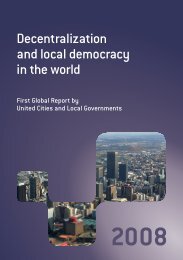Making Cities Resilient Report 2012
Making Cities Resilient Report 2012
Making Cities Resilient Report 2012
You also want an ePaper? Increase the reach of your titles
YUMPU automatically turns print PDFs into web optimized ePapers that Google loves.
CHAPTER 1 | Enabling conditions for building resilience<br />
ENABLING CONDITIONS FOR BUILDING RESILIENCE<br />
Several factors will enable cities to become more resilient to disasters and<br />
motivate local governments to take action, based on an analysis of the<br />
findings of cities and local governments participating in the Campaign.<br />
These include strong leadership and political will; sustainability of<br />
institutional capacities and resources at local level; the ability to engage<br />
in high-impact activities early on; partnerships and city-to-city learning<br />
opportunities; the integration of disaster risk reduction across sectors;<br />
and recognition of the improvements needed to make infrastructure more<br />
resilient. These factors and others form the essential foundations of<br />
resilience.<br />
Leadership and political will<br />
Building political momentum for risk reduction is a key building block for improving disaster resilience.<br />
Particularly where substantial changes to the status quo are necessary, political will is vital in terms of<br />
introducing new and progressive risk reduction practices and policies. Strong, charismatic local leadership<br />
is an important ingredient in building popular support for risk reduction. The ability to engage individuals on<br />
a personal level and stimulate the participation of multiple stakeholders is essential to the effectiveness<br />
and sustainability of disaster reduction plans. This is evident in the example from Siquirres, Costa Rica<br />
(Box 1.1), where visible leadership at the local level is forging close relationships and synergies between the<br />
local government, citizens, and the private sector, while strengthening accountability (11).<br />
BOX 1.1 Political leadership and low-input, high-impact disaster<br />
risk reduction in Siquirres, Costa Rica<br />
Less than six months after joining the Campaign, the local government in Siquirres succeeded in securing<br />
resources for resilience-building activities, undertaking risk reduction measures in infrastructure that have<br />
reduced the incidence of flooding in its communities. They decided to start with two of the Ten Essentials:<br />
Hazard-resilient infrastructure (Essential 4) and education programmes (Essential 7) – and move towards<br />
all ten over time. These were chosen in the interest of getting things moving quickly and delivering rapid<br />
‘concrete’ results.<br />
Prioritising simple hazard mitigation<br />
To date, Siquirres has implemented a small number of simple engineering solutions aimed at reducing<br />
the incidence and impact of flooding in local communities. The banks of a highly flood-prone creek have<br />
been reinforced with concrete, and in three communities, roadside pipes have been enlarged and buried<br />
underground. The visibility of these projects helped to galvanise community support for other longer-term<br />
disaster risk reduction activities.<br />
Yelgi Verley, the young and enthusiastic Mayor of Siquirries, observes that after the implementation of<br />
these small projects, local people are more interested in disaster risk reduction because they understand<br />
their benefits. She says, “we are preventing situations from happening and people are feeling things<br />
being done. People don’t want to hear talk, they want to see things.” The success of the hazard-resistant<br />
infrastructure has been evidenced by the prevention of what were recurring annual floods. In February<br />
<strong>Making</strong> <strong>Cities</strong> <strong>Resilient</strong> <strong>Report</strong> <strong>2012</strong> | 17

















